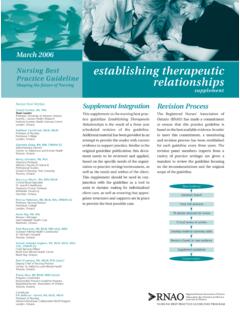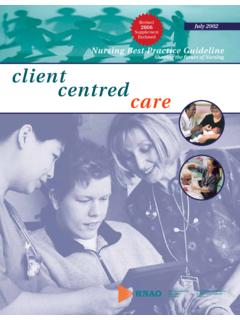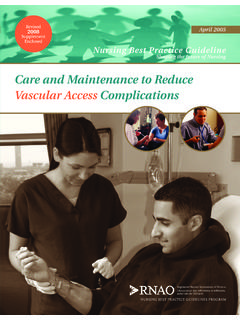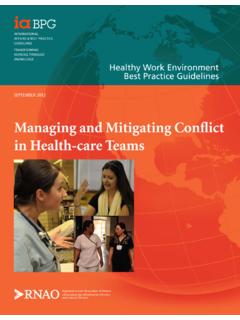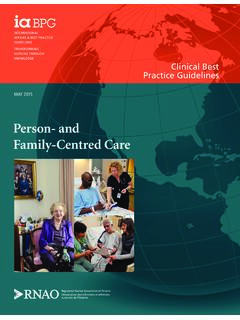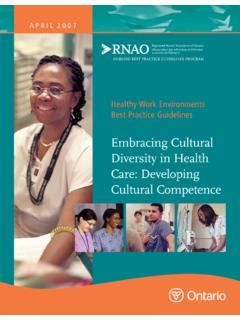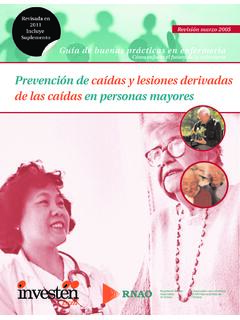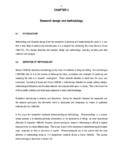Transcription of supporting and strengthening families through …
1 SocietyCommunityFamilySocietyCommunityFa milyIndividualNursing Best Practice GuidelineShaping the future of NursingSupplement IntegrationThis supplement to the nursing best prac-tice guideline supporting and StrengtheningFamilies through Expected and UnexpectedLife Events is the result of a three year sched-uled revision of the guideline. Additionalmaterial has been provided in an attempt toprovide the reader with current evidence tosupport nursing practice. Similar to theoriginal guideline publication, this docu-ment needs to be reviewed and applied,based on the specific needs of the organiza-tion or practice setting/environment, aswell as the needs and wishes of theclient/family. This supplement should beused in conjunction with the guideline as atool to assist in decision making for individ-ualized care, as well as ensuring that appro-priate structures and supports are in placeto provide the best possible care to nursing is a multi-faceted specialtyof nursing .
2 It requires nurses to not onlycare for the individual within the familygroup (family as context), but to also nursethe family as the unit of care (family asclient). Refer to Figure 1. In addition, theterm family as partner has tended to focuson family members who provide care toother members whether they act or feel aspartners in care is debatable (Ward-Griffin &McKeever, 2000). The concept of family-centrednursing needs to be examined further inorder to move beyond the family caregivermodel and to embrace an empoweringpartnership with the family. The aim of thisapproach to family nursing practice is topromote the health of the family. Revision Panel MembersCatherine Ward-Griffin, RN, PhDCo-Team LeaderAssociate ProfessorUniversity of Western OntarioLondon, OntarioClaire Mallette RN, PhDCo-Team LeaderChief nursing OfficerWorker s Safety and Insurance BoardToronto, OntarioHolly Quinn RN, BScNDirector of Clinical ProgramsBayshore Home HealthMississauga, OntarioLeeAnne Rankin-Greene, RN, BScN(c)Staff NurseRoyal Victoria HospitalBarrie, OntarioMaria Rugg RN, BScN, MN, ACNP, CHPCN(c)Clinical Nurse SpecialistThe Hospital for Sick ChildrenToronto, OntarioHeather McConnell, RN, BScN, MA(Ed)Program ManagerNursing Best Practice Guidelines Program Registered Nurses Association of OntarioToronto, OntarioMarch 2006supporting and strengthening families through expected and unexpected life eventssupplementFamily asContextFamily asClientFigure 12 Definitions.
3 The following definition is added to those in the Definition of Terms section starting on page 15 of the Partnership:An empowering partnership between a nurse and a family is a collaborative relationship built on mutual respect and trust, as wellas the sharing of knowledge, skills and experience. Ultimately, families and nurses are empowered to grow and learn together aspartners in the promotion of the health of the ProcessThe Registered Nurses Association ofOntario (RNAO) has made a commitmentto ensure that this guideline is based on thebest available evidence. In order to meetthis commitment, a monitoring and revi-sion process has been established for eachguideline every three years. The revisionpanel members (experts from a variety ofpractice settings) are given a mandate toreview the guideline focusing on the recom-mendations and the original scope of theguideline.
4 The revision panel for theSupporting and strengthening FamiliesThrough Expected and Unexpected LifeEventsguideline consists of original panelmembers, representatives of organizationswho have had experience implementing theguideline, and other recommended experts. The revision panel reflected on the Flower(Em)power Framework and the compo-nents of the nurse-family partnership;advocacy activities and policy; founded onthe vision, values and principles of respect,recognition, resources, responsibility andresults. The framework was used to struc-ture the review/revision discussions toensure consistency of approach with theoriginal guideline. Literature SearchYield 1108 abstracts69 articles retrieved for reviewQuality appraisal of articlesDevelop evidence summary tableRevisions based on new evidenceSupplement publishedDisseminationNew Evidence +Summary of EvidenceThe following content reflects the evidence reviewed that either supports the original recommendations, or provides evidence for revisions.
5 through the review process, no recommendations were added or deleted, how-ever a number of recommendations were reworded to reflect new knowledge. Recommendation 1 Develop an empowering partnership with families by: Recognizing the family s assessment of the situation as essential; Acknowledging and respecting the important role of family in health care situations; Determining the desired degree of family involvement; and Negotiating the roles of both nurse and family within the wording of this recommendation has been revised to reflect the concept of an empowering partnership whichincorporates the previous concept of genuine partnership really knowing about the family and supporting the here and now of the person. The Developmental Model of Health and nursing (DMHN) supports the concept ofempowering partnerships, as the model emphasizes health as a process and the capacities all families have, includingtheir potential for growth and change.
6 Health is seen as a social process that is shaped by the social context of familylife, including social and political realities that may restrict individual and family choices for health. The nurse isviewed as a partner in the family process of developing health (Ford-Gilboe, 2002). An empowering partnership is seen as acollaborative relationship built on mutual respect and trust, as well as the sharing of knowledge, skills and to an empowering partnership is the negotiation of roles and an appreciation of the types of knowledge andauthority that both nurses and families bring to the relationship. Being able to understand the difference between power with and power over approaches in a relationship will assist nurses to develop more empowering negotiatingstrategies within families . Exploring the intrinsic factors that shape different types of family relationships, reviewingempowering negotiating strategies and reflecting on specific experiences with families will help nurses develop positiverelationships that are flexible enough to promote a genuine sharing of both authority and expertise (Ward-Griffin et al.)
7 , 2003). changed unchanged+additional information3 + +Additional Literature SupportsAllen & Warner, 2002; Astedt-Kurki, Tarkka, Paavilainen & Lehti, 2002; Ballard-Reisch & Letner, 2003; Clark & Dunbar, 2003; Ford-Gilboe, 2002; Gill, 2001;Holden, Harrison & Johnson, 2002; Hong, Callister & Schwartz, 2003; Hopia, Tomlinson, Paavilainen & Astedt-Kurki, 2005; Knafi & Deatrick, 2003;Kristjanson, 2004; Kuupelom ki, 2002; Legrow & Rossen, 2005; Mok, Chan, Chan & Yeung, 2002; Sharpe, Butow, Smith, McConnell & Clarke, 2005; Ward-Griffin, Bol, Hay & Dashnay, 2003; Ward-Griffin, Schofield, Vost & Castsworth-Puspoky, 2005 Recommendation 2 Assess family in the context of the event(s) to identify whether assistance is required by the nurse to strengthen andsupport the family. While a family assessment should include information in the following areas, it should be tailoredto address the uniqueness of each family through examining: Family perceptions of the event(s); Family structure; Environmental conditions; and Family wording of the recommendation has been revised to more closely align with the concepts of assessing family inthe context of their perceptions of the event and family as the unit of care (family as client).
8 Ward-Griffin et al. (2005) conducted a descriptive study exploring the perspectives of individuals caring for a familymember with mental illness, with particular attention to the family perspectives of the experience in relation tohousing, quality of supports, and formal care services and to identify potential solutions to difficulties encounteredby families . The researchers found that these families were part of a circle of care , offering support to their mem-bers with mental illness in order to promote their independence, but at the same time trying to protect them fromthe realities of the system. Inadequate and inappropriate resources and supports pushed families into a cycle ofcaregiving that compromised their health and that of their family member. Revisions to the Appendix that supports this recommendation are included on page 7 of this supplement.
9 Additional Literature SupportsAllen & Warner, 2002; Astedt-Kurki et al., 2002; Ballard-Reisch & Letner, 2003; Callahan, 2003; Ford-Gilboe, 2002; Gill, 2001; Holden et al., 2002; Hong etal., 2003; Hopia et al., 2005; Knafi & Deatrick, 2003; Kristjanson, 2004; Mok et al., 2002; Sharpe et al., 2005; Ward-Griffin et al., 2005 Recommendation 3 Identify resources and supports to assist families to address the life event, whether this is expected or should be identified within the following three categories: Intrafamilial; Interfamilial; and et al. (2005) explored the available support and unmet needs of people with advanced cancer, their familycaregivers and their health care professionals. Findings from this study indicate that individuals with advanced cancertended to underestimate the level of support that they received or needed. Health care professionals identified greaterlevels of need than the individual and family caregivers reported, but still underestimated the support needs of theperson and their family.
10 Opportunities need to be made available for individuals and family caregivers to discuss thelife event they are experiencing and the needs they perceive. Providing opportunities for families to identify theirneeds and access resources to address these needs will have a positive impact on family strengths. An ethnographic study conducted by Gill (2001) found that nurses supported breastfeeding mothers by providinginformation and interpersonal support. Breastfeeding mothers identified their support needs as information,encouragement and interpersonal support. The conclusion of this study was that nurses have a positive impact on breast-feeding mothers (and families ), but the resources and support offered must be the kind the mothers ( families ) members provide support to the ill family member, and have needs of support from health professionals.
